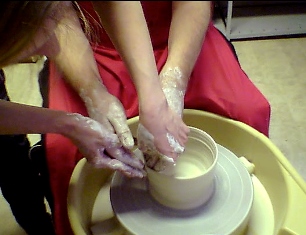Making sense. What can we learn from experts of tactile knowledge?
DOI:
https://doi.org/10.7577/formakademisk.656Keywords:
tactility, embodied knowing, making, clay, deafblindAbstract
This article describes an embodied way of making sense through making with the hands. We examine the potential o ftactile experience in the making process and analyse what tactile experiences mean. The study takes place in the context of an era marked by audio-visual dominance.The article presents a case study that observed and interviewed deafblind makers while they worked with clay. The findings reveal that modelling in clay resembles the visualisation process of sketching. As such, it may contribute to thinking through the hands. Language is not a self-evident communication tool for transferring tactile skills. Based on our case study, we propose the use of tactile communication in the process of transferring tactile knowledge through making with another person’s hands.
Downloads
Published
2013-09-21
How to Cite
Groth, C., Mäkelä, M., & Seitamaa-Hakkarainen, P. (2013). Making sense. What can we learn from experts of tactile knowledge?. FormAkademisk, 6(2). https://doi.org/10.7577/formakademisk.656
Issue
Section
Invited Articles
License
Authors who publish with this journal agree to the following terms:
- Authors retain copyright and grant the journal right of first publication with the work simultaneously licensed under a Creative Commons Attribution 4.0 License that allows others to share the work with an acknowledgement of the work's authorship and initial publication in this journal.
- Authors are able to enter into separate, additional contractual arrangements for the non-exclusive distribution of the journal's published version of the work (e.g., post it to an institutional repository or publish it in a book), with an acknowledgement of its initial publication in this journal.
- Authors are permitted and encouraged to post their work online (e.g., in institutional repositories or on their website) prior to and during the submission process, as it can lead to productive exchanges, as well as earlier and greater citation of published work (See The Effect of Open Access).
- The author(s) must manage their economic reproduction rights to any third party.
- The journal makes no financial or other compensation for submissions, unless a separate agreement regarding this matter has been made with the author(s).
- The journal is obliged to archive the manuscript (including metadata) in its originally published digital form for at least a suitable amount of time in which the manuscript can be accessed via a long-term archive for digital material, such as in the Norwegian universities’ institutional archives within the framework of the NORA partnership.
The material will be published OpenAccess with a Creative Commons 4.0 License which allows anyone to read, share and adapt the content, even commercially under the licence terms:
This work needs to be appropriately attributed/credited, a link must be provided to the CC-BY 4.0 licence, and changes made need to be indicated in a reasonable manner, but not in any way that suggests that the licensor endorses you or your use.



